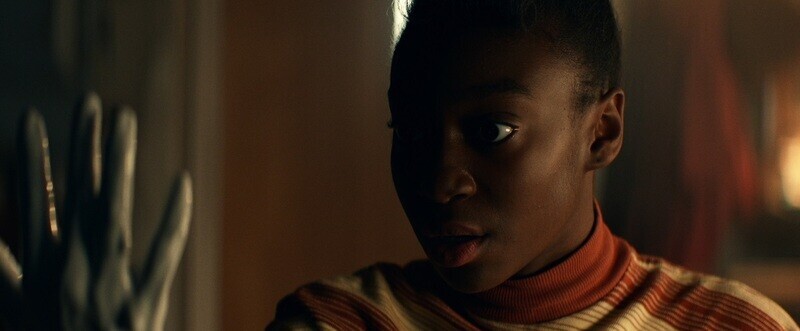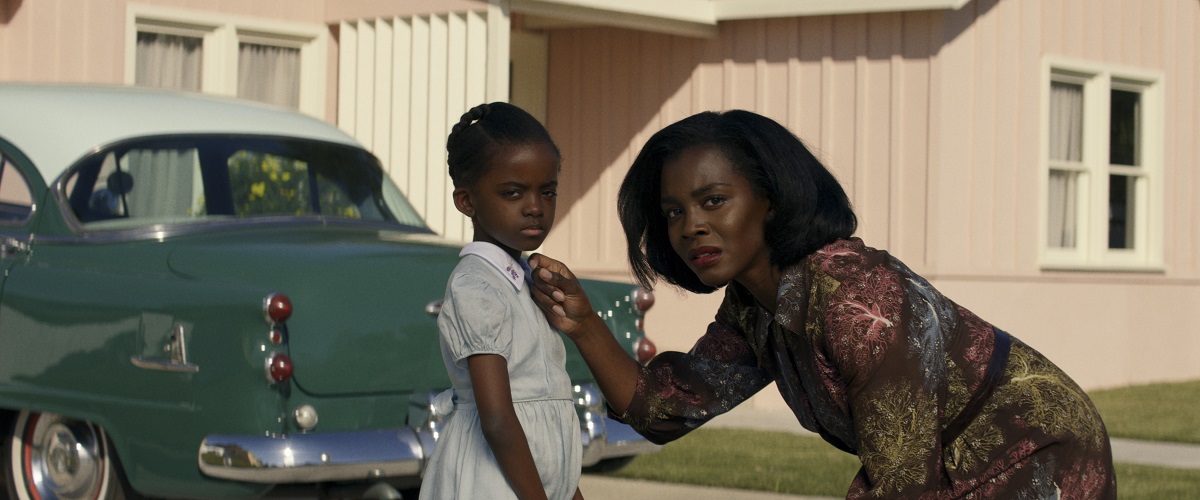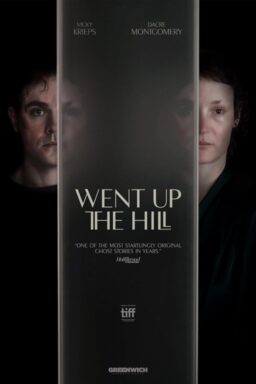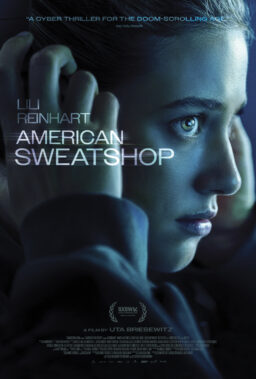Amazon’s “Them” wants its own shelf in the modern horror echelon, especially when it comes to recently made stories about being Black in America. In its response to a nation currently examining the on-camera murder of a Black man by a white police officer, the series created by Little Marvin speaks in serious extremes—it’s ten episodes long, packed with every camera trick in the book, and overflowing with Black American trauma. This is a series that goes there, at full-speed, using a Black family’s suburban hell in the 1950s as a reflection of all that came before and after it. It’s more effectively horrific than it is horror, and easier to accept as loving exploitation than ruthless high-art. Among its many frustrating elements, it brings up larger questions as to when reflective trauma in horror simply becomes a part of the style, despite the grave emotional context.
Taking place over ten days in sunny East Compton, CA, “Them” portrays what happens when the Emorys, a Black family from North Carolina, move into the blindingly white suburb. From the beginning, they are met with overwhelming hostility, as the neighbors all camp outside their new home and blast their radios, sitting in the middle of the street as if they’d rather be hit by a car than have this family in their neighborhood. But Henry Emory (Ashley Thomas) and his wife Lucky (Deborah Ayorinde) agree that they’re not going to run anymore, gritting their teeth through the white noise. With Karen Stepfords like Alison Pill’s Betty leading the charge, the neighbors seek to provoke and dehumanize them while maintaining a false pleasantness toward each other. Episode one ends with the white neighbors poisoning their dog, and this disgusting act inspires Lucky to stand up to them, Henry’s gun in hand. But it only makes the neighbors turn their disgusting fear into even more vitriolic hatred.

Each of the Emorys has an arc that could sustain its own movie, but are placed in here as an intertwining saga of different descents into madness related to identity and racism. Henry starts his job as an engineer fielding all types of racist remarks at work, while being the only Black person in his office. Every time his dopey boss diminishes Henry or says something offensive, Henry doesn’t just bite his tongue, he compresses his entire being. He previously served in World War II, and has proven himself in the field, but he knows that his current environment tells him he has to roll with it. Henry’s storyline appears to be the most fleshed out, especially as his rage leads to a relationship with a supernatural figure with disturbing historical relevancy.
Henry is not alone in seeing supernatural figures, as all of the other Emorys have their own interactions strange beings that reflect their inner turmoil. While dealing with her own trauma (revealed later in the story), Lucky tries to investigate what happened to other Black families who moved to the area, while going through an immense gauntlet of feelings concerning backstory that is later revealed. Meanwhile her 14-year-old daughter Ruby (Shahadi Wright Joseph) wants to be nothing like her mother, and faces her own racism at school. Then there’s young Gracie, the youngest and least developed member of the family, who has her own visions at the Emory home, related to a book she’s been learning from.
These harrowing stories are expressed with expansive emotional work from its main cast, especially as the narrative often sends them right into trauma. It’s only later in the second half (160 minutes or so later) that it feels like the narrative builds beyond its desire to mirror real terror, and starts to ask about what happens when these characters fight back, making decisions from which they can’t turn back. But then the machinations of the story take over, and “Them” clumsily mixes its supernatural and ripped-from-the-headlines horror.
The setting for all of this is the ornate, hollow suburbia of the 1950s, in which we get loving glimpses of immaculate living rooms and gaudy wallpaper, not to mention the occasional TV set and plenty of pristine dresses. It’s as elegant as the show’s cinematography, which is constantly in pursuit of one perfect shot. Even though there’s so much suffering in “Them” as it drags from episode to episode in the first half, the style nearly takes over. It’s present every time that the camera starts to go topsy-turvy during a sinister conversation, or puts two faces in a split-screen so that we can see them cry in unison, or when a period-appropriate radio hit is meant to cue a sunny nightmare. Style becomes “Them”’s way of getting the audience to pay attention to the immense pain and anger that it portrays, but instead it helps push out the vital human nuance.

“Them” shows that it’s not afraid to be horrifying and mash buttons of discomfort, especially as the Emorys face more and more disgusting terror from their neighbors. But the show struggles with a good scare. Bits of jump-scares with shadowy figures (Amazon has asked reviewers not to go into more detail) are almost used as reminders that this is not just a brutal examination of this racism but is also meant to be entertaining, as scary stories usually are. Directed by reliable genre fixtures like Daniel Stamm (“The Last Exorcism”), Ti West (“The Innkeepers”), or Craig William Macneill (“Lizzie“), these sequences often don’t work because of their automatic construction and familiar rhythms; it helps less when freaky hallucination sequences start to feel redundant, as if a much shorter production absolutely would have cut them. In the first half especially, they add to the show’s repetitive nature that’s only poignant when based in experience (like Henry’s work days). The context of these corny scares is often emotional, but in relying so much on horror language, the meaning can be lost in translation.
The horror of the series becomes a type of incredibly pointed storytelling device throughout, and it starts to take up more and more space. Take the series’ long focus on white supremacy angles, like with Alison Pill’s Betty. For all that she gives her grotesque performance, with her forced smile and forceful presence among her fellow peers, the scenes focusing on white characters in general play out like padding (there’s small diversions about other neighbors and a milkman, for good measure). Again and again, their scenes of scheming against the Emorys or talking about them in such dehumanizing ways remind the viewer that these people are the villains—something we readily accept from the beginning, but are given so little do with. A larger idea overall of the corrosive nature of white supremacy, and how it can harm its own members, is made more and more obvious.
The series’ most effective episode comes in the middle, as directed by Janicza Bravo (“Lemon“). Bravo’s episode reaches a climax that, like lots of passages in “Them,” pushes its style in front of its storytelling, but is at least more fitting than the series’ usual jump-scare supernatural horror—it treats its evil elements as a pervasive, unstoppable force like something out of “A Clockwork Orange.” It’s extremely brutal for a show that already has a great deal of pain before it. But in the scheme of the series’ picturesque flaws, Bravo’s challenging episode relishes its disorienting music choices and editing and makes a point with its terror by being so ruthless, and so ugly.
When trying to appreciate more of “Them” and all that it’s striving for, there’s a strange production choice that does not entirely pass the smell test—it largely favors white horror film directors for its storytelling (and men for nine of its ten episodes). This feeling adds even more to the series having a weary approach, giving it an awkward air of being driven by aesthetics and letting pervasive whiteness take control in one way or another. What does it mean when a show so explicitly about Black trauma is barely being steered by Black directors? And how many Black directors did they initially approach?
“Them” can be an incredibly tenuous series, whether one tries to watch it as brutal entertainment or an ornately shot way to honor traumatic experiences of racist violence in the past, present, and future. The discord appears to come from its two impulses, of both wanting to be gnarly, in-your-face, over-the-top exploitation, while desiring the elegance of high art. It loves the Emorys, but also wants to see how much they can take. Picking a side between those impulses can often determine what a character’s body and soul means to a particular story, and how we as audience members should take experiences that may not explicitly be our own. In depicting all of its history with equally zealous bluntness and style, “Them” too often raises the question of whether this is at all the best way to be doing it.
All of season one screened for review.












